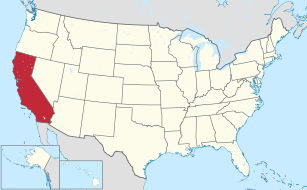Alma (1891)
Alma is an 1891-built scow schooner, which is now preserved as a National Historic Landmark at the San Francisco Maritime National Historical Park in San Francisco, California.
 Alma under sail, c. 1900 | |
| History | |
|---|---|
| Builder: | Fred Siemer |
| Launched: | 1891 |
| Status: | Museum ship |
| General characteristics | |
| Tonnage: |
|
| Length: |
|
| Beam: | 22.6 ft (6.9 m) |
| Depth of hold: | 4 ft (1.2 m) |
| Sail plan: | Schooner |
Alma (Scow Schooner) | |
Starboard view of scow schooner Alma Hyde Street Pier, San Francisco Maritime National Historic Park | |
 | |
| Location | 2905 Hyde St. (Hyde St. Pier), San Francisco, California |
| Coordinates | 37°48′37.5″N 122°25′22″W |
| Built | 1891 |
| Architect | Fred Siemer |
| NRHP reference No. | 75000179 |
| Significant dates | |
| Added to NRHP | 10 October 1975[1] |
| Designated NHL | 7 June 1988[2] |
History
Alma is a flat-bottomed scow schooner built in 1891 by Fred Siemer at his shipyard at Hunters Point in San Francisco. Like the many other local scow schooners of that time, she was designed to haul goods on and around San Francisco Bay, but now hauls people. Able to navigate the shallow creeks and sloughs of the Sacramento and San Joaquin River Delta, the scows' strong, sturdy hulls could rest safely and securely on the bottom and provided a flat, stable platform for loading and unloading. While principally designed as sailing vessels, scow schooners could also be hauled from the bank or poled in the shallows of the delta.
Until 1918, Alma hauled a variety of cargo under sail, including hay and lumber. Thereafter she was demasted and used as a salt-carrying barge. In 1926 a gasoline engine was installed, and Alma became an dredging oyster schooner, remaining in this trade until 1957.
While built and operated on San Francisco Bay, Alma is in many ways indistinguishable from scows that were launched and sailed on Chesapeake Bay, the Gulf Coast, the Great Lakes, inland rivers, and other coastal waters of the United States. No scow schooners except Alma are known to survive afloat in the United States.[3]
In 1959, Alma was purchased by the State of California and restoration commenced in 1964. She was added to the National Register of Historic Places on 10 October 1975.[1] In 1988, she was designated a National Historic Landmark.[2][4] She is now one of the exhibits of the San Francisco Maritime National Historical Park and is to be found moored at the park's Hyde Street Pier.
See also
Sources
- "National Register Information System". National Register of Historic Places. National Park Service. January 23, 2007.
- "Alma (Scow)". National Historic Landmarks Program. National Park Service. Archived from the original on 2007-11-14. Retrieved 2008-02-13.
- "Scow Schooner "Alma"". List of Classified Structures. National Park Service. 17 November 2008. Archived from the original on 2 March 2012. Retrieved 23 August 2012.
- Delgado, James P.; Foster, Kevin J. (1 July 1987). "National Register of Historic Places Inventory-Nomination: Scow Schooner Alma / Alma". National Park Service. Retrieved 2012-08-22.
Delgado, James P.; Foster, Kevin J. (1 July 1987). "Accompanying 5 images, from c.1971 and undated". National Park Service. Retrieved 2012-08-22.
- "Title unknown". Archived from the original on January 26, 2005. Retrieved 2005-01-23.

